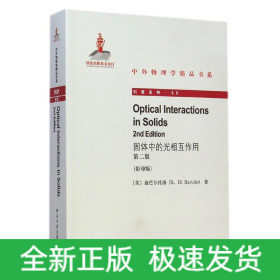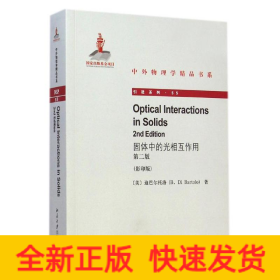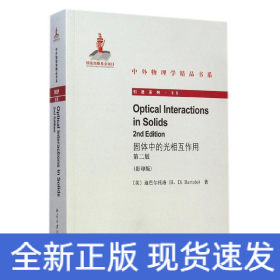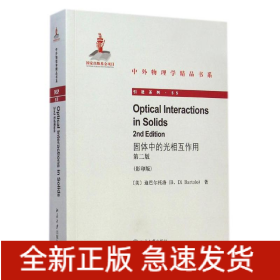
固体中的光相互作用
正版保障 假一赔十 可开发票
¥ 70.62 6.6折 ¥ 107 全新
库存2件
作者(美)迪巴尔托洛(B. Di Bartolo)著
出版社北京大学出版社
ISBN9787301251720
出版时间2012-12
装帧平装
开本16开
定价107元
货号8398407
上书时间2024-10-27
- 最新上架
商品详情
- 品相描述:全新
- 商品描述
-
目录
Preface to the Second Edition vii
1. Elements of Quantum Mechanics 1
1. Review of ClassicalMechanics . . . . . . . . . . . . . . . . 1
2. Vector Spaces and Linear Operators . . . . . . . . . . . . 4
3. Basic Postulates of Quantum Mechanics . . . . . . . . . . 10
4. Compatible Observables and Complete Set
of Commuting Operators . . . . . . . . . . . . . . . . . . . 13
5. Formof the Operators . . . . . . . . . . . . . . . . . . . . 15
6. Matrix Formalism and Transformation Theory . . . . . . . 20
7. General Theory of Angular Momentum . . . . . . . . . . . 29
8. Time-Independent Perturbation Theory . . . . . . . . . . 35
9. Time-Dependent Perturbation Theory . . . . . . . . . . . 42
References . . . . . . . . . . . . . . . . . . . . . . . . . . . 48
2. Elements of Group Theory 49
1. Properties of a Group. . . . . . . . . . . . . . . . . . . . . 49
2. Classes . . . . . . . . . . . . . . . . . . . . . . . . . . . . . 51
3. Theory of Representations . . . . . . . . . . . . . . . . . . 53
4. Schurs Lemma and Orthogonality Relations . . . . . . . . 58
5. Characters of a Group . . . . . . . . . . . . . . . . . . . . 61
6. Properties of the Irreducible Representations
of a Group . . . . . . . . . . . . . . . . . . . . . . . . . . . 64
7. The Direct Product Representation . . . . . . . . . . . . . 65
8. Product Groups and Their Representations . . . . . . . . 66
9. Summary of Rules . . . . . . . . . . . . . . . . . . . . . . 68
10. Groups of Real Orthogonal Matrices . . . . . . . . . . . . 69
11. Space Groups and Symmetry of Crystalline Solids . . . . . 75
12. The Irreducible Representations of a Group of Primitive
Translations . . . . . . . . . . . . . . . . . . . . . . . . . . 92
13. The Irreducible Representations of Space Groups . . . . . 95
References . . . . . . . . . . . . . . . . . . . . . . . . . . . 113
3. Connection of Quantum Mechanics with
Group Theory 115
1. The Effect of an Orthogonal Coordinate Transformation on
the Vectors of a Hilbert Space . . . . . . . . . . . . . . . . 115
2. The Symmetry Group of the Schr¨odinger Equation . . . . 117
3. The Fundamental Theorem for Functions
and OperatorsTransforming Irreducibly . . . . . . . . . . 121
4. The Construction of Functions Transforming
Irreducibly . . . . . . . . . . . . . . . . . . . . . . . . . . . 124
5. The Full Rotational Group and the Quantum Theory
of Angular Momentum . . . . . . . . . . . . . . . . . . . . 127
6. The Spin of the Electron and the Double Valued
Representations . . . . . . . . . . . . . . . . . . . . . . . . 137
7. The KramersDegeneracy . . . . . . . . . . . . . . . . . . 142
8. The Symmetric Group of the Hamiltonian and the Pauli
Principle . . . . . . . . . . . . . . . . . . . . . . . . . . . . 148
References . . . . . . . . . . . . . . . . . . . . . . . . . . . 154
4. The Hydrogen Atom 155
1. The Unperturbed Hamiltonian . . . . . . . . . . . . . . . . 155
2. The Spin-Orbit Interaction . . . . . . . . . . . . . . . . . . 157
3. The Zeeman Interaction . . . . . . . . . . . . . . . . . . . 160
4. Group Theoretical Considerations for the H Atom . . . . . 162
References . . . . . . . . . . . . . . . . . . . . . . . . . . . 164
5. The Complex Atom: Multiplet Theory 165
1. The Helium Atom. . . . . . . . . . . . . . . . . . . . . . . 165
2. The Many Electron Atom . . . . . . . . . . . . . . . . . . 169
3. Group Theoretical Considerations for a Complex Atom . . 176
4. The Energies of Spectral Terms . . . . . . . . . . . . . . . 180
5. Hunds Rules and the Principle of Equivalence
of Electrons and Holes . . . . . . . . . . . . . . . . . . . . 188
6. The Spin-Orbit Splitting of Terms . . . . . . . . . . . . . . 190
7. An Example of Spin-Orbit and Zeeman Splitting . . . . . 193
References . . . . . . . . . . . . . . . . . . . . . . . . . . . 195
6. The Magnetic Ion in a Crystal: The Role of Symmetry 197
1. Bonding in Crystals . . . . . . . . . . . . . . . . . . . . . . 197
2. The Ionic Bond in Crystals . . . . . . . . . . . . . . . . . 198
3. Electronic Configurations and Properties
ofMagnetic Ions . . . . . . . . . . . . . . . . . . . . . . . 201
4. The Crystalline Field Hypothesis . . . . . . . . . . . . . . 212
References . . . . . . . . . . . . . . . . . . . . . . . . . . . 216
7. The Weak Field Scheme 217
1. The Hamiltonian of the Free Ion . . . . . . . . . . . . . . 217
2. The Crystal Field Perturbation . . . . . . . . . . . . . . . 218
3. Application of theWeak Field Scheme . . . . . . . . . . . 219
4. Splittings of J Levels in Fields of Different
Symmetries . . . . . . . . . . . . . . . . . . . . . . . . . . 223
References . . . . . . . . . . . . . . . . . . . . . . . . . . . 223
8. The Medium Field Scheme 225
1. The Hamiltonian of the Free Ion . . . . . . . . . . . . . . 225
2. The Crystal Field Perturbation . . . . . . . . . . . . . . . 227
3. The Spin-Orbit Interaction . . . . . . . . . . . . . . . . . . 228
4. An Application of the Medium Field Scheme . . . . . . . . 228
5. The Method of Operator Equivalents: The Splitting of
Transition Metal Ions Levels in an Octahedral
Crystal Field . . . . . . . . . . . . . . . . . . . . . . . . . 230
References . . . . . . . . . . . . . . . . . . . . . . . . . . . 235
9. The Strong Field Scheme 237
1. The Unperturbed Hamiltonian . . . . . . . . . . . . . . . . 237
2. The Crystal Field Perturbation . . . . . . . . . . . . . . . 239
3. The Electrostatic Interaction. . . . . . . . . . . . . . . . . 240
4. The Spin-Orbit Interaction . . . . . . . . . . . . . . . . . . 241
10. Covalent Bonding and Its Effect on Magnetic
Ions in Crystals 243
1. The Relevance of Covalent Bonding . . . . . . . . . . . . . 243
2. The Formation of Molecular Orbitals . . . . . . . . . . . . 244
3. Example of Molecular Orbitals Formation . . . . . . . . . 246
4. The Use of Projection Operators in the Construction
ofMolecularOrbitals . . . . . . . . . . . . . . . . . . . . . 258
5. The Formation of Hybrids . . . . . . . . . . . . . . . . . . 262
6. Hybrids of the Central Ion in a Tetrahedral
Complex AB4 . . . . . . . . . . . . . . . . . . . . . . . . . 267
7. Hybrids of the Central Ion in an Octahedral
Complex AB6 . . . . . . . . . . . . . . . . . . . . . . . . . 269
8. The Combinations of Ligand Orbitals in an
ABn Complex . . . . . . . . . . . . . . . . . . . . . . . . . 271
9. The Energy Levels of an ABn Complex . . . . . . . . . . . 274
References . . . . . . . . . . . . . . . . . . . . . . . . . . . 282
11. The Quantum Theory of the Radiation Field 283
1. The Classical Electromagnetic Field . . . . . . . . . . . . . 283
2. The Quantum Theory of the Electromagnetic Field . . . . 286
12. Molecular Vibrations 295
1. The Classical Theory of Molecular Vibrations . . . . . . . 295
2. The Symmetry of the Molecules and the
Normal Coordinates . . . . . . . . . . . . . . . . . . . . . 299
3. How to Find the Normal Modes of Vibration . . . . . . . . 300
4. The Use of Symmetry Coordinates . . . . . . . . . . . . . 303
5. The Quantum Theory of Molecular Vibrations . . . . . . . 307
6. The Selection Rules for Infrared and Raman Transitions,
The Fermi Resonance . . . . . . . . . . . . . . . . . . . . . 309
7. The Normal Modes and the Symmetry Coordinates
of a Tetrahedral Complex AB4 . . . . . . . . . . . . . . . 312
8. The Normal Modes and the Symmetry Coordinates
of an Octahedral Complex AB6 . . . . . . . . . . . . . . . 315
References . . . . . . . . . . . . . . . . . . . . . . . . . . . 321
13. Lattice Vibrations 323
1. The Geometry of Crystalline Solids . . . . . . . . . . . . . 323
2. Lattice Vibrations of an Infinite Crystal with
One AtomPer Unit Cell . . . . . . . . . . . . . . . . . . . 326
3. Lattice Vibrations of a Finite Crystal with
One AtomPer Unit Cell . . . . . . . . . . . . . . . . . . . 329
4. Lattice Vibrations of a Crystal with More Than
One AtomPer Unit Cell . . . . . . . . . . . . . . . . . . . 336
5. Thermodynamics of Phonons . . . . . . . . . . . . . . . . 339
6. Phonons and Photons. Similarities and Differences . . . . 346
References . . . . . . . . . . . . . . . . . . . . . . . . . . . 347
14. The Ion-Photon Interaction: Absorption and
Emission of Radiation 349
1. The Ion-Radiation Interaction . . . . . . . . . . . . . . . . 349
2. The Expansion of the Interaction Hamiltonian:
Different Types of Radiation . . . . . . . . . . . . . . . . . 351
3. The Density of Final States . . . . . . . . . . . . . . . . . 353
4. The Transition Probability Per Unit Time . . . . . . . . . 354
5. Dipole Radiation . . . . . . . . . . . . . . . . . . . . . . . 356
6. Selection Rules for Radiative Transitions . . . . . . . . . . 358
7. About the Intensities of Radiative Transitions . . . . . . . 369
8. The Static Effects of the Interaction Between
an Atomic System and the Electromagnetic Field . . . . . 373
References . . . . . . . . . . . . . . . . . . . . . . . . . . . 374
15. The Judd-Ofelt Theory 375
1. Motivation . . . . . . . . . . . . . . . . . . . . . . . . . . . 375
2. General Considerations . . . . . . . . . . . . . . . . . . . . 376
3. The Theory . . . . . . . . . . . . . . . . . . . . . . . . . . 377
4. Applications . . . . . . . . . . . . . . . . . . . . . . . . . . 381
References . . . . . . . . . . . . . . . . . . . . . . . . . . . 382
16. The Ion-Vibration Interaction. Radiationless
Processes, Thermal Shift, and Broadening
of Sharp Lines 385
1. The Ion-Vibration Interaction . . . . . . . . . . . . . . . . 385
2. Radiationless Processes in Crystals . . . . . . . . . . . . . 387
3. Different Types of Line Broadening Mechanisms:
Lorentzian a
相关推荐
-

固体中的光相互作用
全新北京
¥ 63.08
-

固体中的光相互作用9787301251720
全新广州
¥ 71.90
-

【图片参考按书名发货】固体中的光相互作用
全新北京
¥ 63.10
-

辐射与固体的相互作用*
八品昆明
¥ 40.00
-

固体中的光相互作用 (第二版)(英文影印版)
全新广州
¥ 64.03
-

固体中的光相互作用 (第二版)(英文影印版)
全新广州
¥ 62.03
-

固体中的光相互作用 (第二版)(英文影印版)
全新广州
¥ 64.03
-

固体中的光相互作用 (第二版)(英文影印版)
全新广州
¥ 62.03
-

固体中的光相互作用 (第二版)(英文影印版)
全新广州
¥ 62.03
-

固体中的光相互作用 (第二版)(英文影印版)
全新东莞
¥ 64.05
— 没有更多了 —













以下为对购买帮助不大的评价